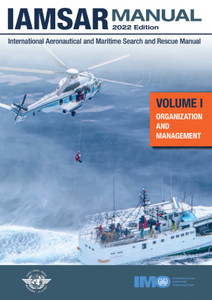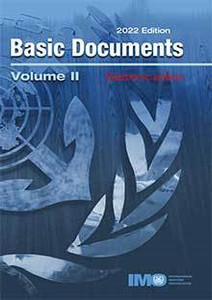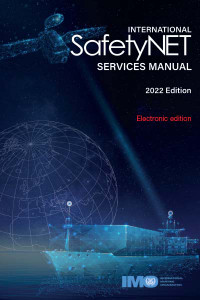
The Mission Coordination volume assists personnel who plan and coordinate SAR operations and exercises.The Mission Coordination volume assists personnel who plan and coordinate SAR operations and exercises.
A new edition of the IAMSAR Manual is published every three years. The 2022 edition includes amendments, adopted by the International Civil Aviation Organization (ICAO) and approved by the Maritime Safety Committee of the International Maritime Organization (IMO) at its 103rd session in May 2021 by means of MSC.1/Circ.1640, which become applicable on 1 June 2022.
The primary purpose of the three volumes of the International Aeronautical and Maritime Search and Rescue Manual (IAMSAR Manual) is to assist States in meeting their own search and rescue (SAR) needs, and the obligations they accepted under the Convention on International Civil Aviation, the International Convention on Maritime Search and Rescue, 1979 and the International Convention for the Safety of Life at Sea, 1974 (SOLAS). These volumes provide guidelines for a common aviation and maritime approach to organizing and providing SAR services. States are encouraged to develop and improve their SAR services, cooperate with neighbouring States and to consider their SAR services to be part of a global SAR system. Each volume of the IAMSAR Manual is written with specific SAR system duties in mind, and can be used as a stand-alone document, or, in conjunction with the other two volumes, as a means to attain a full view of the SAR system. Depending on the duties assigned, it may be necessary to hold only one or two, or all three volumes. The Organization and Management volume (volume I) discusses the global SAR system concept, establishment and improvement of national and regional SAR systems, and cooperation with neighbouring States to provide effective and economical SAR services; The Mission Coordination volume (volume II) assists personnel who plan and coordinate SAR operations and exercises; and The Mobile Facilities volume (volume III) is intended to be carried aboard rescue units, aircraft and vessels to help with performance of a search, rescue, or on-scene coordinator function and with aspects of SAR that pertain to their own emergencies
Foreword
Abbreviations and acronyms
Glossary
Chapter 1 The search and rescue system
1.1 System organization
1.2 SAR coordination
1.3 SAR resources
1.4 Medical assistance to vessels
1.5 Plans of operation
1.6 SAR operations stages
1.7 Mission documentation
1.8 Training and exercises
1.9 Improving professionalism
1.10 Public relations
1.11 Computer resources
1.12 Decision and management support
Chapter 2 Communications
2.1 Distress communications
2.2 Aeronautical mobile service
2.3 Maritime radio service
2.4 Modes of emission
2.5 Global Maritime Distress and Safety System
2.6 406 MHz distress beacons – EPIRB, ELT and PLB
2.7 Satellite communications
2.8 Vessel–aircraft communications
2.9 Survival and emergency radio equipment
2.10 Mobile telephones – satellite and cellular
2.11 Special circumstances
2.12 Communications for SAR operations
2.13 Communication equipment identities
2.14 False alerts
2.15 SAR data providers
2.16 RCC and RSC communications
2.17 Maritime radio telex
2.18 Maritime safety information services
2.19 Broadcast services
Contents
iv IAMSAR MANUAL VOLUME II (2022 EDITION)
2.20 Radio telegraph
2.21 Phonetic alphabet and figure code
2.22 Spoken emergency signals and procedural words
2.23 On-scene communications
2.24 Electronic positioning
2.25 Codes, signals and standard phrases
2.26 First RCC
2.27 SAR operations communications
2.28 SAR operations messages
2.29 GMDSS Master Plan
2.30 Supplemental capabilities
2.31 Difficulties in contacting vessels
2.32 Unbarring of Inmarsat SESs by RCCs
2.33 Radio call signs for aircraft involved in a search and rescue operation
2.34 Vessel tracking communications
2.35 Additional device considerations
2.36 Social media
Chapter 3 Awareness and initial action
3.1 General
3.2 SAR stages
3.3 Emergency phases
3.4 Awareness stage
3.5 Initial action stage
3.6 Designation of the RCC or RSC responsible for initiating SAR action
3.7 RCC procedures for requesting SAR facilities
3.8 General considerations for the SMC
Chapter 4 Search planning and evaluation concepts
4.1 Overview
4.2 Evaluating the situation
4.3 Estimating the distress incident location
4.4 Survivor motion after the distress incident
4.5 Total probable error of position
4.6 Search planning and evaluation factors
4.7 Optimal search effort allocation
4.8 Computer-based search planning aids
Chapter 5 Search techniques and operations
5.1 Overview
5.2 Selection of search facilities
5.3 Assessing search conditions
5.4 Selecting search patterns
5.5 Visual search patterns
5.6 Electronic search patterns
5.7 Night search patterns
Contents
IAMSAR MANUAL VOLUME II (2022 EDITION) v
5.8 Land search patterns
5.9 Search object motion
5.10 Assignment of search sub-areas to individual facilities
5.11 Designation and description of search sub-areas
5.12 Planning on-scene coordination
5.13 Search action plans
5.14 Conduct of the search
5.15 Briefings
5.16 Aircraft search procedures
5.17 Surface facility search procedures
5.18 Search by land facilities
5.19 Debriefing of search personnel
5.20 Continuation of search
5.21 Geographic referencing
Chapter 6 Rescue planning and operations
6.1 General
6.2 Sighting and subsequent procedures
6.3 Delivery of rescue personnel and equipment
6.4 Supplies and survival equipment
6.5 Supply dropping
6.6 Medical personnel
6.7 Rescue by aircraft
6.8 Rescue by maritime facilities
6.9 Rescue by land facilities
6.10 Use of pararescue teams
6.11 Special requirements at aircraft crash sites
6.12 Ditching assistance
6.13 Rescue of persons from inside damaged, capsized, or ditched craft
6.14 Underwater search and rescue
6.15 Mass rescue operations
6.16 Search and rescue within areas remote from SAR facilities
6.17 Care of survivors
6.18 Debriefing of survivors
6.19 Handling of deceased persons
6.20 Critical incident stress
6.21 Termination of rescue
Chapter 7 Multiple aircraft SAR operations – General guidance
7.1 Overview
7.2 Area of SAR action
7.3 Aircraft coordinator (ACO)
7.4 Communications
7.5 Search mission
7.6 Evacuation missions
Contents
vi IAMSAR MANUAL VOLUME II (2022 EDITION)
7.7 Long-range operations
7.8 Effects of the environment and weather
Chapter 8 Emergency assistance other than search and rescue
8.1 General
8.2 Intercept and escort services
8.3 Safety information
8.4 Unlawful acts
8.5 Search and rescue outside of RCC responsible areas
8.6 Assistance to property
8.7 Aerodrome emergency plan
Chapter 9 Conclusion of SAR operations
9.1 General
9.2 Closing a SAR case
9.3 Suspending search operations
9.4 Reopening a suspended case
9.5 Final reports
9.6 Performance improvement
9.7 Case studies
9.8 Archiving case files
9.9 Incident debriefings
Appendices
Appendix A Distress communications
Appendix B Message formats
Appendix C Mass rescue operations: exercises, industry roles and incident management
Appendix D Uncertainty phase data
Appendix E Alert phase data
Appendix F Distress phase checklist
Appendix G Facilities and equipment selection
Appendix H Operation briefing and tasking forms
Appendix I SITREPs and MAREC Code
Appendix J Intercepts
Appendix K Determining datum
Appendix L Search planning and evaluation worksheets
Appendix M Preparing initial probability maps
Appendix N Tables and graphs
Appendix O Ship reporting systems for SAR
Appendix P Functional characteristics to consider with computer-based search planning aids
Contents
IAMSAR MANUAL VOLUME II (2022 EDITION) vii
Appendix Q Sample problem
Appendix R Medical assistance at sea, TMAS – TMAS Medical information exchange form
Appendix S Search planning for 121.5 MHz distress beacon alerts
Appendix T Checklists and guides for multiple aircraft SAR operations
Appendix U Mobile telecommunications device location process
Appendix V Autonomous distress tracking of aircraft in flight
A??s a specialized agency of the United Nations, IMO is the global standard-setting authority for the safety, security and environmental performance of international shipping. Its main role is to create a regulatory framework for the shipping industry that is fair and effective, universally adopted and universally implemented.
In
other
words,
its
role
is
to
create
a
level
playing-field
so
that
ship
operators
cannot
address
their
financial
issues
by
simply
cutting
corners
and
compromising
on
safety,
security
and
environmental
performance.
This
approach
also
encourages
innovation
and
efficiency.
Shipping
is
a
truly
international
industry,
and
it
can
only
operate
effectively
if
the
regulations
and
standards
are
themselves
agreed,
adopted
and
implemented
on
an
international
basis.
And
IMO
is
the
forum
at
which
this
process
takes
place.
- Number of Pages:
- 540
- Published Date:
- April 2022
- Book Height:
- 250 mm
- Book Width:
- 210 mm
- Author:
IMO
- Preview:
- Yes
- Publication Date:
- April 2022






